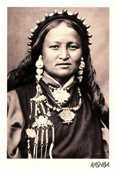Home
KASHBA Asiatica
Ais Loupatty
Ton Lankreijer
Staalstraat 6
1011 JL Amsterdam
Open 12:00 – 17:00
Zondag / Sunday 14:00 - 17:00
GESLOTEN / CLOSED
16 okt - 5 nov '25
Contact:
31-20 - 6 23 55 64
06 - 588 41 370
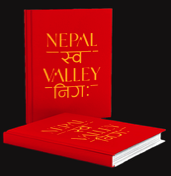
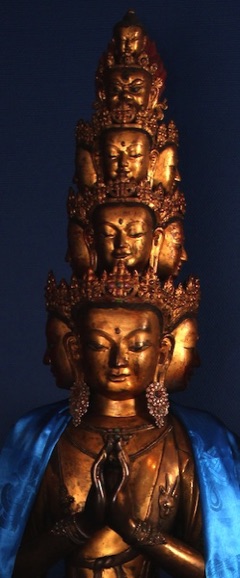
On the top floor of the Wereldmuseum in Rotterdam a life-size sculpture of Avalokitesvara stands at the entrance to the Tibetan collection.
The statue personifies love, compassion and unity. Even so, it has a remarkable history of violence.
To bring back its looted symbolism to its former glory, we participated in its restoration for the past couple of years.
The fact that many old paintings and sculptures were created in times when a large part of humanity could read nor write, is sometimes overlooked. What remained was the visual language to convey – mostly religious – messages.
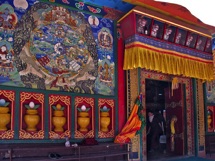
At every Tibetan temple, for example, the essence of the concepts is explained in a large, painted wheel of life besides the entrance.
Usually Avalokitesvara is depicted here as well.

For billions of people in various cultures Avalokitesvara has been a guide in their spiritual life since millennia.
Although the outward forms differ, the underlying bodhisattva-concept is everywhere the same.
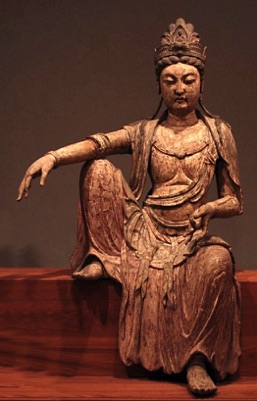
Whoever expects people in other parts of the world to know who Jesus Christ or Johan Cruyff were, might in turn memorize some of these names:
Avalokiteshvara (India), Nātha (Celon), Padmapani (Nepal), Guanyin (China), Chenrezig (Tibet), Kannon (Japan).
Whether it is a man or woman, changes through the centuries and is clearly irrelevant here.
Guanyin, wood. The 'open sit’ indicates willingness to step from throne or lotus to help. China.

Tibet.
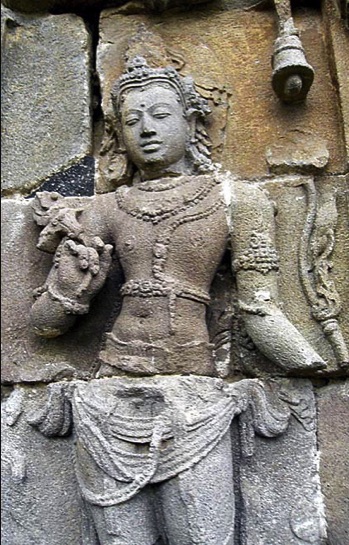
India
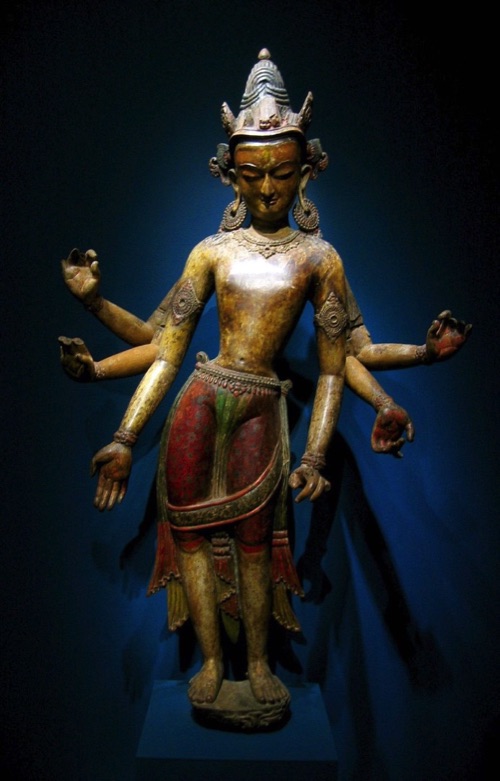
Nepal

Gebedsdoos, Tibet
Nepal
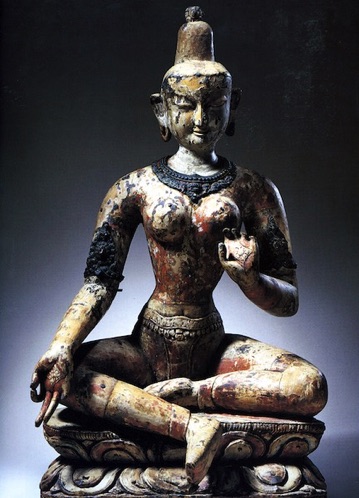
Waarschijnlijk Tara, geboren uit een traan van Avalokitesvara, Nepal.

Nepal

What does the widespread bodhisattva-concept imply, what does the Tibetan-Chinese image in the Wereldmuseum exactly express?
- The many heads indicate that compassion is not pity, but is associated with wisdom.
- The many arms indicate that understanding can only result in action, to see is to act (which not necessarily implies doing something).
- The handheld symbols clarify the important aspects of compassion in detail (see at the end).
In each hand an eye may have been placed to emphasize that the spontaneous affection to help others is not blind emotion or sentiment, but that compassion arises from recognizing the suffering and sorrow of all beings on earth.
Or as the old sage phrases it: ‘You are the world and the world is you. It's not your or my sorrow.’
In sixties-language: ‘I am he as you are he as you are me and we are all together.…’
In self-help language: ‘Working on yourself by being there for others.’
In Cruyffian (heard the soccer player say it the other day in a documentary): ‘You should always start individually, of course, but it is all about the total.’
Precisely today, the Volkskrant reports about the discovery that bees communicate through vibrations of their wings.
More bees halted their dances during an attack by a giant hornet and fewer bees left the nest when the danger was right at the entrance. Bee-expert Koos Biesmeijer is enthusiastic about the new findings.
‘Time and again communication amongst bees turns out to be more complicated than imagined,’ he says. Remarkably, the colony takes successful decisions, although not one bee does exactly know what's going on. ‘It is as if you’re looking at a brain. The bees form one super-organism in which the behaviour of all the individuals together leads to patterns that are favourable for the colony.’ How this works exactly, is gradually being unraveled.
It reminds one of schools of fish that simultaneously by the thousands take the same elegant turn.
Tibet
Or the hundreds of starlings that regularly come to chirp for an hour or so in the two tall poplars behind my house and then all of a sudden, wooshhh, unanimously decide to go elsewhere before the sun goes down.
Japanese symbol for impermanence.
But also of the dozens if not hundred and eight corresponding buddha-statues in a temple: numerous and individual, traditional and unique, timeless and impermanent…

Tibet

Religion speaks of existing deities, buddhism of projections. Besides art, the images and symbols are little more than direction-signs along the path of a spiritual person.
Buddhist schools and monasteries, however, like to turn it into religion and profession. Still, it's as the old sage suggested: ‘No one at the time did really listen to the Buddha, that’s why we have buddhism.’
Perhaps this is true of any kind of religion.
As every church and mosque, temples also have rules and obligations. Over the centuries monastic communities have been keen on creating lists of do's and don'ts - as if it were a kind of spiritual ludo game.
There is an old rule that states that you should buy a statue at the workshop of the artist. Dutch often translate it as ‘One should not buy a Buddha oneself, but be presented with one’ which probably says more about the Dutch than about buddhism. Obviously, the old rule is intended to prevent theft from temples. Whenever a family or community died out, the sacred objects and images were usually left at a temple.
Cambodja.
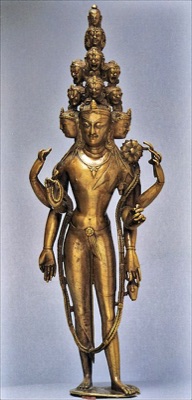
Virtually every ancient religious statue began to wander through the mundane world after robbery or theft. No doubt one can reverse this proposition: a lot of religious art began with robbery and theft (from a heavily toiling population).
Once stolen, the common cultural heritage usually disappears into private property. Perhaps a public museum as a temporary resting place, wherever, is not so bad – even though items may disappear or perish in the dark vaults called depots.
Timely exchange or sale reflects a sensible approach; nothing is eternal, not even a museum, everything is impermanent.
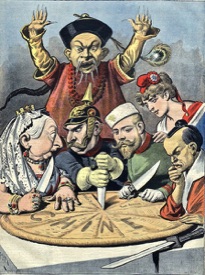
During the drought of 1899, China's population rebelled against as many as eight imperialist nationalities occupying their land and against the foreign reli-fanatics who decried their traditional beliefs.

Simultaneously Chinese elites seized upon the chaotic times to fight all kinds of power struggles amongst themselves.
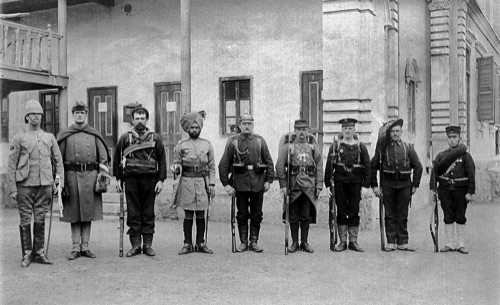
For almost a century China's population fell prey to abuse of power and arbitrariness – something I tend to forget while reading about the later ruthless maoist red brigade.
Soldiers of the eight different occupants.

One of the opposition groups was called Yihetuan – translated as Fists of Righteous Harmony – which led to the western name of Boxer Rebellion.
The rebellious peasants, devoid of education and steeped in superstition, considered themselves invulnerable and were consequently easily slaughtered and manipulated by both imperial and foreign rulers.
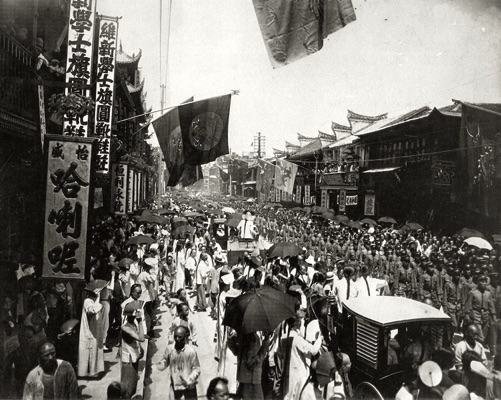
Shanghai
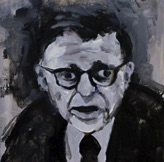
You know very well that we are exploiters. You know very well that we took the gold and the metals and then the oil of the ‘new continents’ and brought them back to the old mother countries. Not without excellent results: palaces, cathedrals, industrial capital; and then whenever crisis threatened, the colonial markets were there to cushion or deflect it. Europe, stuffed with riches,

On the latter Mark Twain wrote a caustic essay with a biblical quote for title – ‘To the Person Sitting in Darkness’ – which was on the front pages in the United States for much of 1901. ‘We have gone there to conquer, not to redeem.’
We, in this case, were no less than eight nationalities:
After the Boxer Rebellion, each nationality accused others of being the worst looters. An American diplomat, Herbert G. Squiers, needed several railroad cars for his loot. The British Legation stated that ‘looting by part of the British troops was carried out in the most orderly manner’ – on their grounds a booty auction was organized every afternoon.

Many foreigners, including Sir and Lady Claude Maxwell MacDonald and George E. Morrison of The Times, were active bidders among the crowd. Many of these looted items ended up in Europe. The Catholic North Cathedral was a ‘salesroom for stolen property.’ The American commander General A. Chaffee banned looting by American soldiers, but the ban was ineffectual. - wikipedia
Out of this chaotic violence the Avalokitesvara statue arrived in Europe. It remained virtually undamaged, except for the matching symbols that had disappeared from its hands.
The Peking to Paris Motor Race, 1907
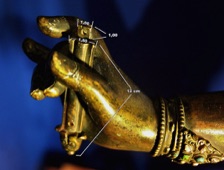
From remnants in two of the hands I concluded that they had not been broken off but rather carefully removed. Perhaps they had been auctioned separately or lost during transport by pushcart and ship.
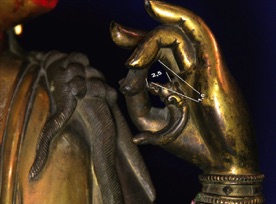
After auctions and wanderings in London and Paris the statue eventually found a resting place in the Wereldmuseum in Rotterdam.

At the invitation of the Bodhimanda foundation the Fourteenth Dalai Lama visited the upper floor in May 2014 to ceremonially consecrate the extensive temple display, in fact the room is dedicated to him.

In his role as spiritual leader Tenzin Gyatso is supposed to propagate the bodhisattva thought. A large number of Tibetans worship him as an incarnation of Avalokitesvara.
Therefore, it would be lamentable, if not insulting, to receive him in a sacred hall that opens with a damaged image of ‘himself’. Moreover, it would undoubtedly remind him and his entourage of the smashing and destruction of the Tibetan culture by Mao's Red Brigade during the sixties.
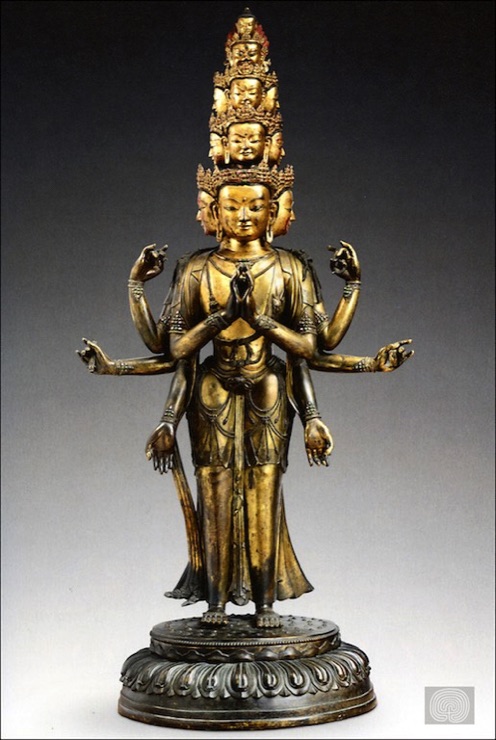
Foto Wereldmuseum

The six hands were empty but every hand pose clearly indicated that something was missing. On request we started to look one and a half year before his arrival for artists in Nepal who mastered the skills to recreate the five missing symbols (one of the hands shows a mudra and remains empty).
The larger the statue, the smaller the number of craftsmen that are
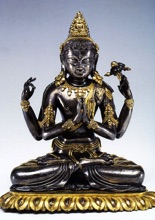
Discussing possible materials and variants within Tibetan art, we ultimately decided on an entirely different metal: silver.
To be more precise: silver blackened by natural oxidation – which could take a lustrum or more in the controlled air of a museum.
At the time I had this statue in mind:
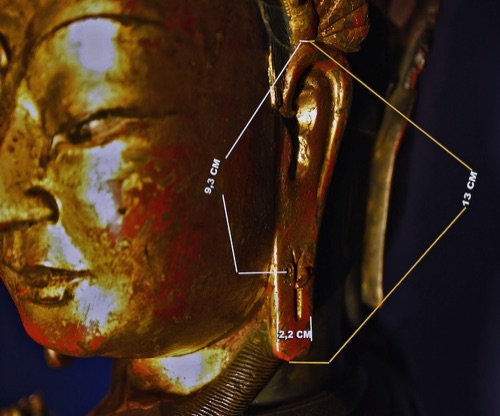
On three Mondays, when the museum is closed, I took measurements, photographs and molds of the in- and outsides of each hand.
In workplaces in Nepal the box with documentation was kindly inspected – and discarded. It took me a while to realize that old hands in the craft only require the height of the statue.
Whether the symbols would actually fit the palms in Rotterdam, inevitably remained in the hands of the Buddha.

Right below: open, giving gesture.
(Varada mudra)
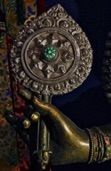
Right middle: the wheel that Sakyamuni’s teachings set in motion.
(Dharma chakra)

Right top: a rosary of 108 beads. Meditative devotion.
(Mala)
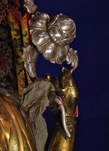
Above left: a lotus grows out of mud through deep water to the surface to unfold in sunlight. Symbol of enlightenment.
(Padme)
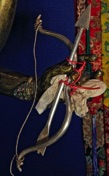
Left middle: bow and arrow, attention and knowledge.

Left below: a water pot as a symbol of germination. (Kalash)

Despite the crowds surrounding him during his visit to the top floor of the Wereldmuseum, the Dalai Lama paused for a moment in front of the big statue.
Reading his face, all was in order.

‘A very good collection.’ Over three times he expresses his consent during the visit.
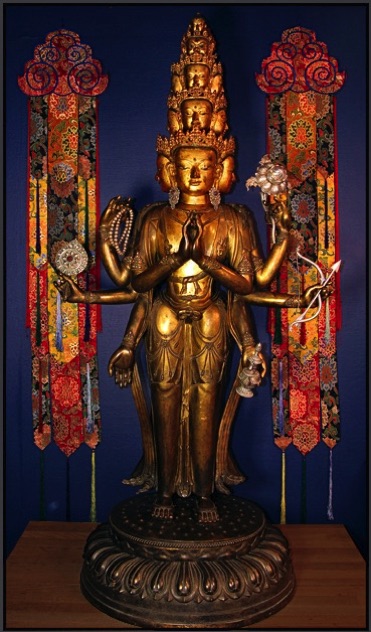
granted de jure humanity to all its inhabitants: a human, in our case, means ‘accomplice’, since we have all benefited from colonial exploitation… What empty chatter: liberty, equality, fraternity, love, honour, country and who knows what else? – Jean-Paul Sartre (Situation V)
Everybody is complicit because we could do something about it.
After almost three years, the victory was celebrated by the eight countries with an 'orgy of looting’ as one British newspaper described it pointblank. Palaces and houses were seized, occupied and plundered by foreign soldiers, merchants, journalists, adventurous money-grubbers and missionaries.
England, Germany, France, Italy, Japan, Austria, Russia and the United States.
able to handle such an assignment: to visualize and realize in large proportions is a craft in itself.
The man-sized statue consists of fire-gilt bronze. After forty years of having witnessed, and unavailingly resisted, antique finishing techniques, I know how to get the same patina. Fortunately, the sense of kitsch also troubled the curator, Lambert Verhoeven.
All photographs and texts ©Kashba Ais Loupatty & Ton Lankreijer.Webdesign:William Loupatty
